The people in this and nearby valleys had come to think of this land as their homeland, as their place in the world; it was good to stay in one place. They knew of many other peoples in nearby and distant valleys that were like themselves and had similar traditions and beliefs, but they preferred their life on the Naconichi.
The families have felt that life in their world was changing, that they were part of something bigger that is in flux, but powerful. Social linkages with the broader world were growing—especially with communities on the big rivers to the north and west, a 3-4 day walk—and those groups were developing new ways of cultivating and growing plant foods that seemed to have good promise. If maize and other crops could be grown more dependably, life might be easier on the Naconichi.
There were new ideas, new rituals, and new ways of looking at the people’s way of life that were talked about around the fire, in councils, or while resting under the arbor. How they might affect the Naconichi was unknown, but they seemed to herald closer social and religious ties with some of their neighbors. One of the people had heard about a big feast that was to be held at the recently established village and mound center on the Cah-ye-tsi (the Neches River), and there was much anticipation as to what that feast would foretell for them all. The people were sure that the Caddi Ayo (God) would be near on the Naconichi.
Prehistoric Caddo Archeology at Lake Naconiche
The development of sedentary life along Naconiche Creek appears to have taken place after ca. A.D. 800 by hunter-gatherer and pottery makers amongst what we consider the earliest Caddo residents of the valley. Neither the adoption of pottery or the cultivation of maize or other crops appear to have been triggering events that led to the ability of these people to maintain multi-seasonal residences in the same places or their effort to establish their own distinctive identities as groups of related kin.
Woodland period sites had been widely distributed on many different kinds of landforms, implying a generalized use of a wide variety of habitats for settlements as well as foraging pursuits. The earliest Caddo settlements were apparently rare, both locally and regionally, suggesting low populations. Subtle settlement shifts on the landscape may have been in response to changes in subsistence (i.e., the growing of cultivated plants), but significant settlement changes did not occur in the area until after ca. A.D. 1300.
The character of ceramics in the 7th-8th centuries A.D. and the 9th-10th centuries A.D. components suggest continuities in some aspects of ceramic style and technology from Woodland to early Caddo times. These provide hints from whence at least some East Texas Caddo groups may have originated.
By A.D. 800, Lake Naconiche sites were no longer occupied by Mossy Grove groups making sandy paste pottery or living as mobile hunting-gathering foragers. After A.D. 800, were the aboriginal groups living along Naconiche Creek Caddo peoples or acculturated Mossy Grove folks? Some findings from the Lake Naconiche archeological investigations are relevant to this issue of ethnic affiliations and local and regionally momentous cultural changes.
The stone tools and ceramic vessels found on sites in East Texas dating to A. D. 800-850 clearly identify them as being made by the prehistoric ancestors of the Caddo Nation of Oklahoma. These prehistoric Caddo peoples, in all their diversity of origins, material culture, subsistence, and rituals and beliefs, seem to have created their societies by establishing places on the land that became home, and the ancestors of the Naconichi Caddo were no exception. Established places likely lent order to the chaotic worlds of people and nature, and they embodied history and the cosmos here on earth.
These Caddo lived in permanently occupied settlements. Gradually they began to grow maize and other cultigens (beans and squash, with beans apparently becoming important after ca. A.D. 1300). They lived primarily in dispersed communities led by a social hierarchy of priests, civic leaders, and other elites. The most powerful leaders lived at the civic-ceremonial centers placed at key locations across the landscape: major river crossings, and at the intersection of trails and major foot paths. The closest civic and ceremonial center to the Lake Naconiche sites is an important multiple mound group at the Washington Square Mound site (41NA49), about 10-15 miles to the south (in today's Nacogdoches). This multiple mound center and associated village was occupied and used in the 13th-15th centuries A.D., contemporaneous with the most intensive prehistoric Caddo settlement at Lake Naconiche. Early Caddo mound centers were present on the Sabine River at the Boxed Springs (41UR30) and Hudnall-Pirtle (41RK4) sites, well away to the north and northwest of the Lake Naconiche sites, and some 50 miles to the southwest at the George C. Davis site. The considerable distance to mound centers in Early Caddo times suggests that the early Boyette site occupation was at the outer reaches of communities focused at these mound centers. The local region does not appear to have been heavily populated at this time, given that there are relatively few Caddo habitation sites of this age known in most of East Texas.
Caddo ceramic technology and decorative styles documented at the Lake Naconiche sites suggests that the closest affiliations of the local Caddo groups from the 13th century A.D. onward are with communities not far to the north and east in the middle reaches of the Sabine River basin, and to the south and east in the Angelina and Attoyac river basins. The Lake Naconiche Caddo sites lies near the center of this broad ceramic tradition. This area was occupied in historic times by numerous Caddo groups that were affiliated with the Hasinai Caddo, including the Nasoni, Nadaco, Hainai, and Nacogdoche.
The main Caddo occupations at Lake Naconiche took place during relatively warm and wet weather conditions. Yet Caddo peoples also lived along Naconiche Creek during the onset of less optimal (i.e., pronounced colder and drier weather) climatic conditions around ca. A.D. 1450. Most of the investigated sites at Lake Naconiche were abandoned by ca. A.D. 1480, if not before, about the time of the onset of the Little Ice Age (ca. A.D. 1450).
The Caddo sites at Lake Naconiche have middens and/or features, and are interpreted as small homesteads or farmsteads probably occupied on a permanent basis for 10-20 years at a time. The most intensive Caddo occupation of the Naconiche and Telesco Creek valleys took place after ca. A.D. 1200, and lasted until the early to middle part of the 17th century. One sherd of the Historic Caddo ceramic type Patton Engraved recovered during the test excavations at the Cedar Branch site (41NA244), indicates a transitory use of the Telesco Creek valley after ca. A.D. 1650 by the Naconichi Caddo, and two sherds of Patton Engraved have also been recovered from the Naconiche Creek site. By the early 1800s, there were no Caddo living in the area.
The early Caddo occupation at Lake Naconiche is best seen at the Boyette site. It was contemporaneous with the earliest Alto phase component (mid-9th century) at the George C. Davis site (Caddoan Mounds State Historic Site) on the Neches River. However, the ceramic fine wares and the utility wares found at Boyette do not suggest that it was a component of the Alto phase, although such sites have been identified in the Angelina River basin. Components of this phase are not common anywhere in the region. Only a handful of sherds from the Boyette site come from pottery types common at George C. Davis.
The few similarities in vessel decorations in both fine wares and utility wares between the Boyette site and George C. Davis site are indicative of contemporaneous Caddo occupations—and perhaps even a modicum of contact/interaction—but they are not part of the same Caddo groups. Instead, the Boyette site was apparently part of a local and culturally separate Caddo community in the Attoyac Bayou basin, one that may be ancestral to the Naconichi Caddo.
One question that languishes unanswered is the cultural relationship between the latest Mossy Grove sites in East Texas and the earliest Caddo sites in the region. Concerning the historical traditions of the Alto phase Caddo peoples, archeologist Dee Ann Story commented that “there are no earlier archeological remains in the middle and upper Neches River basin that can plausibly be identified as an antecedent complex to the Alto phase component [at the George C. Davis site].” She went on to speculate that “earlier Caddoan developments [earlier than the late A.D. 800s] must have taken place elsewhere, probably to the northeast in either the Sabine or Red River basins.” These suggestions go hand in hand with the notion that the George C. Davis Caddo mound center and associated village represents a founding colony in a part of East Texas that was not previously within the territory occupied by Caddo peoples.
James A. Corbin also subscribed to the notion that the Caddo occupation of much of East Texas, especially those areas south and west of the Sabine River, originated outside of East Texas and that the Caddo were newcomers to the region. He proposed that the Caddo populations who had come into the area in the A.D. 800s lived coevally with the Mossy Grove Culture peoples who were already there, and that these peoples continued “their dispersed lifestyle, only slightly displaced on the landscape, with the additions of maize, better pottery and the bow and arrow.” Under this scenario, Corbin concluded that:
indigenous Woodland population was acculturating and modifying some of what was early Caddo culture into their own lifestyle to create a post-early Caddoan culture we call Late Caddo on a cultural base that was already in place and never disappeared. The only place where early Caddo blinked into almost instantaneous existence in this area was at a few specific sites.
The prehistoric occupations at the Boyette site are relevant to the questions and scenarios posed by Story and Corbin. From radiocarbon dates obtained in the excavations, there are two occupations of interest, an earlier one that dates from ca. A.D. 670-850 and a later one with Caddo tradition ceramics that dates between A.D. 870-1075. Two of the four dates have an age range of A.D. 710-1000 , while the other two have an range of A.D. 980-1180. These radiocarbon ages suggest that the second occupation may be represented by two different episodes of settlement.
The earlier of the two occupations has sandy paste Mossy Grove ceramics, Gary and Kent dart points (and probably some early arrow point forms), a few features, but no evidence of structures, middens, burials, or use of cultigens. In most respects, the early occupation at Boyette was a fairly typical Mossy Grove occupation. What is distinctive about this component is that decorated sandy paste vessel sherds are atypically abundant (more so than any other known Mossy Grove component). The incised, incised-punctated, and punctated decorative elements almost eerily presage the same ceramic vessel decorations noted in the later ca. A.D. 870-1075 component. In the latter occupation, these styles of vessel decoration are common on both sandy paste and tempered pottery wares. There are also at least a few examples of non-traditional vessel forms in the ca. A.D. 670-850 component, including carinated bowls and a bottle. Such vessel forms are well represented in the later Caddo component, as they are in post-A.D. 1100 Naconiche Caddo ceramic vessel assemblages.
What about the ca. A.D. 960 component: was it affiliated with the Caddo or was it an acculturated Mossy Grove site? First, cultigens such as maize are absent in the archeological deposits, although the numbers and arrangements of features suggest that this occupation was a relatively sedentary one. There are stemmed arrow points in the assemblage, including those of the Alba type (the dominant type in the Alto phase), as well as a typical range of Caddo flake tools and drills, large bifaces and cores, as well as ground stone tools.
There was also an abundance of ceramic vessel sherds, including many from carinated bowls and bottles that have engraved designs (i.e., Holly Fine Engraved and Hickory Engraved) much like those noted from other early Caddo contexts in the region. Much of the pottery is tempered—primarily with grog (crushed pottery)—but sandy paste pottery remained common and was often decorated with the same elements found on tempered wares, even including some engraving.
From the evidence at hand from the Boyette site, it appears that there were changes in material culture—the use of temper in the manufacture of pottery vessels, subtle changes in vessel form, and innovations in pottery vessel decoration —that were either underway by the mid-8th century and/or had been adopted by the aboriginal peoples living along Naconiche Creek by the late 9th century, a period of some 150 years. The choice and inspiration to decorate sandy paste pottery cannot be laid at the feet of any Caddo colonizers from the George C. Davis site because this was taking place at least one century before the appearance of that site on the Neches River. The same may be said for the appearance of carinated bowl and bottle forms in late Mossy Grove contexts at the Boyette site.
Such innovations as these appear to have developed amongst Mossy Grove groups without having to invoke a Caddo “influence,” if that is relevant in the context posed by Story and Corbin. Ceramic innovations such as adding temper to the paste of vessels, or even choosing to decorate a vessel after it was fired rather than while the vessel still had a wet paste, were not beyond the creative reach of the people that lived along Naconiche Creek.
Thus, the 9th and 10th century occupation at the Boyette site is not viewed as one by acculturated Mossy Grove groups influenced by the superior culture of the Caddo who were expanding into the area. Rather, the 7th and 8th century population at Lake Naconiche is considered directly antecedent to the 9th and 10th century population that lived at the Boyette site. The preponderance of archeological evidence from this later occupation indicates that the population that lived there was Caddo, or at least one of many different groups living in East Texas that can be considered Caddo in an ethnic and cultural sense.
The 7th and 8th century A.D. population is considered ancestral to the Caddo. This does not mean that the Woodland or earliest Caddo populations in the Attoyac Bayou basin had any ethnic or underlying genetic relationship with a founding population at George C. Davis—that issue still remains to be resolved. It does mean that the George C. Davis Caddo population was not the only one in East Texas in the 9th century A.D.
|
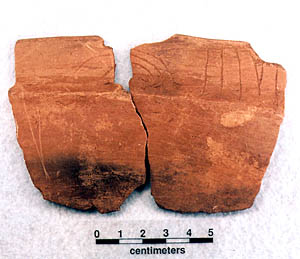
Fine ware engraved vessels were abundant in pre-A.D. 1100 contexts at the Lake Naconiche sites.  |
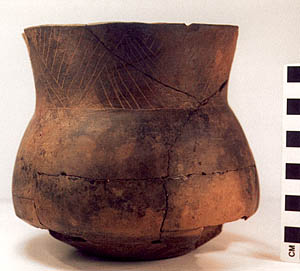
Holly Fine Engraved globular bowl found within a burial of a female adult discovered at Boyette. 
|
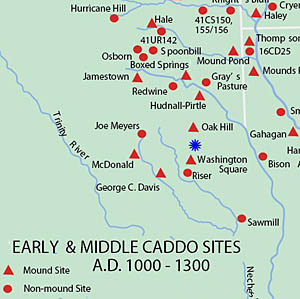
The Lake Naconiche area is the blue star shown on this map of Early and Middle Caddo sites. Base map by Dee Ann Story.  |
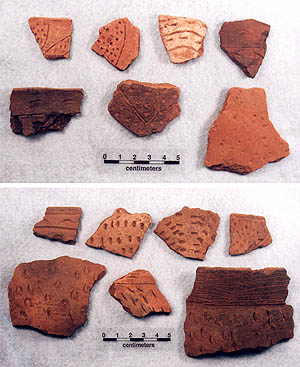
Sherds of tempered pottery utility wares found at Boyette. Enlarge to read more detail. |
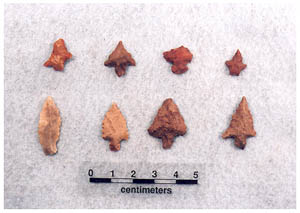
Projectiles found at Block II at the Boyette site. Enlarge to see more projectiles and their descriptions.  |
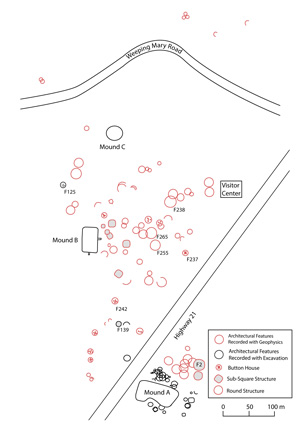
The Early Caddo George C. Davis Caddo mound center and associated village (Caddoan Mounds State Historic Site) lay some 50 miles to the southwest of the Lake Naconiche area. The early Caddo occupation at the Boyette site was contemporaneous with the earliest Alto phase component (mid-9th century) at the Davis site.  |
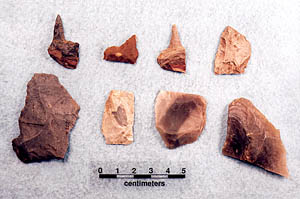
A typical range of Caddo flake tools and drills found at Boyette.  |
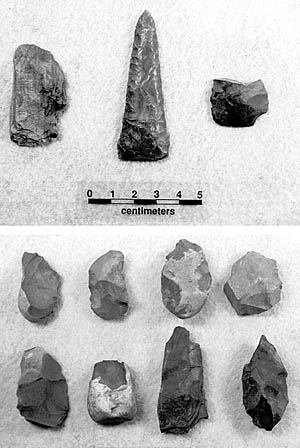
Caddo bifaces and cores found at Boyette.  |
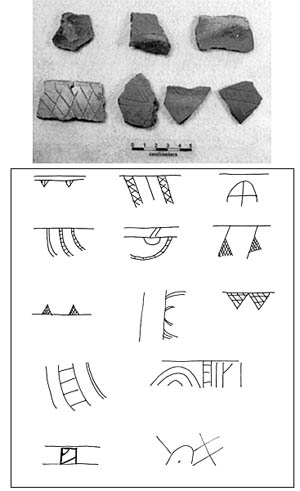
Caddo ceramic sherds and engraved designs from the Boyette site assemblage. Enlarge to see more specimens.  |
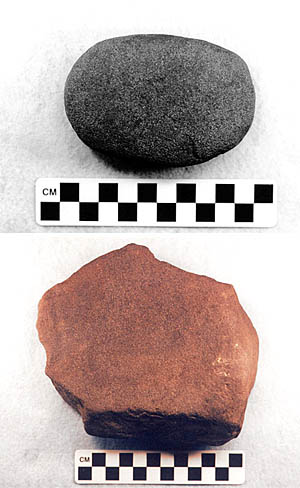
Caddo ground stone tools found at Boyette, a mano and pitted stone (top) and a mortar fragment.  |
|